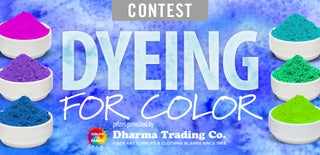Introduction: Mess-free Dyeing With Kool-Aid
These instructions focus on dyeing silk yarn, but any protein yarn can be dyed with Kool-Aid and a similar process can be used to dye loose fibre and fabric. Protein fibres include nylon as well as animal fibres such as wool and alpaca.
All the dyeing is done in a lidded dish in the microwave. There is absolutely no mess, and it’s quick and safe. You can use your ordinary cooking dishes and utensils. The process is very forgiving - you can build up the colour gradually and see exactly how things are progressing, stopping when you get the depth of colour you want. And it only needs three ingredients: yarn, Kool-Aid and vinegar.
At this point, if you’re not American you’re probably wondering, “What on earth is Kool-Aid?”. It’s a concentrated drink powder aimed at children which comes in a multitude of fruity flavours and lurid colours. The colours are achieved by means of synthetic food colourings that are closely related to the acid dyes commonly used in the textile industry for wool, silk and other protein fibres. Some of these food colourings are no longer used in children’s products in Europe, because they have been associated with hyperactive behaviour. That might make you reluctant to drink Kool-Aid, but contact with it isn’t going to do you any real harm.
Kool-Aid is available in the UK. Look out for it in small independent grocers and on market stalls, or buy it online from Ebay, Amazon or Candy Hero. It’s inexpensive and a single sachet will dye up to about 25g/1oz of yarn a deep colour, or about twice that much yarn a pastel shade. The photo above shows several flavours and the colours they produce - the packet colour is a pretty good guide. Look for Red 40, Blue 1 or Yellow 5 in the ingredients list on the back of the packet. The drink powder already contains citric and ascorbic acid so there's no need to add anything other than water, although a pre-soak in dilute vinegar helps.
For this project you will need:
- Natural coloured silk yarn - I used bourette silk
- At least one sachet of unsweetened Kool-Aid powder
- A little distilled malt vinegar
- Gentle shampoo or other liquid detergent for washing
- A microwave oven
- A lidded microwaveable dish, preferably clear glass with no tint
- A stainless steel spoon
- A jam thermometer (not essential for silk)
A jam jar (if you aren't going to use the whole sachet at once)
Dyeing a few lengths of yarn for a knitting project such as the one in the photo above makes more sense than buying lots of different coloured balls. You can just dye more as you need it.
If you like this Instructable, please vote for it in the Dyeing for Color contest & the Three Ingredient challenge.
Step 1: Measuring and Skeining the Yarn
Measure the length of the silk yarn you are going to dye – I wrap yarn around a metre-long measuring stick, count the number of wraps and double it. Then work out what weight of fibre this represents, using the information on the ball band which should say how many metres/yards are in a full ball/skein. Alternatively, if you are dyeing more than say 2oz/50g or have access to scales that will weigh smaller quantities, just weigh it.
Wrap the yarn around some suitable object (I use a paperback book) to create a mini-skein for each colour you’re going to dye.
Knot the two ends of each skein to each other and hold the skein together in two or more places with loose figure-of-eight ties of a different white or undyed yarn/thread. (Coloured ties may transfer dye to the yarn, and using a different yarn avoids confusion when untying and provides an opportunity to see how it takes the dye.)
Step 2: Preparing the Yarn
Wash the skeins gently in warm water with a little detergent added – washing-up liquid or baby shampoo is supposed to be better for silk than soap flakes or laundry detergent. This step is necessary because the yarn might contain spinning oils or other additives that could prevent the dye fixing properly onto the fibre.
Rinse the yarn in warm water until all the bubbles have gone, then leave the skeins to soak for 12-24 hours in a lidded microwave-proof glass dish containing just enough warm water from the kettle to cover them and a splash of distilled (colourless) malt vinegar. If necessary, use something inert (eg a stainless steel spoon) laid over the top of the yarn to keep it all below the surface of the water.
Step 3: Preparing the Dye Bath
You’ll need 1-2 sachets of Kool-Aid per 25g/1oz of yarn for deep colours (more with some flavours such as Lemonade), about half that amount for pastel shades. There’s only about 4g in a packet which makes weighing out small quantities impossible unless you have super-accurate scales, so dilute a full packet in warm water to make 100ml of solution and then it’s easy to get the right amount by measuring out the liquid – a teaspoon holds about 5ml or you probably have a set of measuring spoons in a kitchen drawer. But there’s no need to be precise unless you’re aiming for reproduceable results, and if in doubt go for less, you can always add more later (see next step).
Lift the silk skeins out of the glass dish and leave them temporarily on the upturned lid while you add the Kool-Aid powder or solution to the water that was used for soaking. Stir well with a stainless spoon. The powder must be fully dissolved. You shouldn’t need more water to cover the yarn, but add some from the kettle if you are having trouble getting the Kool-Aid to dissolve. (NB. It is the ratio of Kool-Aid to yarn that matters, not the strength of the dyebath. Adding more water will not result in a paler shade. However, a weaker liquor should make it easier to achieve an even colour.) Then put the skeins back in and give them a gentle stir to distribute the dye liquor through them.
Step 4: Dyeing
The dyebath needs to be heated, but to no more than 80ºC (175ºF) or the silk could lose its lustre. The temperature should be monitored closely, ideally with a thermometer (eg a meat probe or a jam thermometer), but if you don’t have one then you will just have to judge the temperature from the amount of steam given off, the number of bubbles rising to the surface, how hot the glass dish feels to the touch, etc.
I give the dish successive bursts of 30 seconds on high to start with, checking the temperature with my hands and eyes after each one. As the temperature gets to the point where the dish is too hot to hold, I ease off. The aim is to keep the dyebath at or close to 80ºC until the bath clears or the yarn has turned an acceptably deep shade. It won't take more than a minute or two for this to happen once it gets up to temperature. Silk, unlike wool, doesn’t felt so there is no need to worry about the temperature going up and down repeatedly.
If the dyebath exhausts (turns colourless) before the yarn is dark enough, no problem. Just remove the skeins temporarily from the dish while you add more Kool-Aid like in the previous step. You could add a different flavour to get a mixed colour, eg a tiny amount of Stawberry (red) on top of Lemonade (yellow) will give orange.
Allow the yarn to cool completely in the dyebath. If the dye had not exhausted completely when it was hot, more colour may attach itself to the fibre during the cooling stage. You may find that no more colour will exhaust because the yarn has taken up as much colour as it is capable of. You could remove that skein and add another undyed one to make best use of the Kool-Aid.
You can stop the dyeing process while there is still colour left in the bath if you want. Just go straight to the rinsing stage.
Step 5: Rinsing and Drying
Pour off the dye liquor - it can go down the drain safely because it's only a soft drink.
Rinse the skeins in warm water, then wash with a little detergent and keep rinsing until the water runs totally clear.
Gently squeeze out the skeins and blot them in a clean towel. Hang them up to dry out of direct sunlight but preferably in the fresh air to get rid of the fruity Kool-Aid smell.
When the yarn is still a little damp, untie the skeins and wrap the yarn reasonably tightly around a lemonade bottle or something similar to finish off drying. That should ensure that it ends up smooth and kink-free.
Step 6: Finally
Any unused Kool-Aid solution can be kept in a jam jar in the fridge to dye another day. I've kept it successfully for a couple of weeks. Label each jar with the flavour and what proportion of a packet it contains.
Dyeing wool in the microwave requires more care, because temperature variation can lead to felting unless the yarn has been treated to make it machine washable. To use this method successfully for wool you will probably need to monitor the temperature closely with a thermometer and give microwave blasts of just a few seconds at a time to maintain a steady temperature. Also keep agitation to a minimum. However, wool can take surprisingly high temperatures if it is not shocked by hot-cold cycling.
Now all that remains is to knit or crochet something wonderful with your newly-dyed yarn. The shawlette pattern in the photo is Leftie.

Fourth Prize in the
Dyeing for Color Contest

Participated in the
Three Ingredient Challenge













